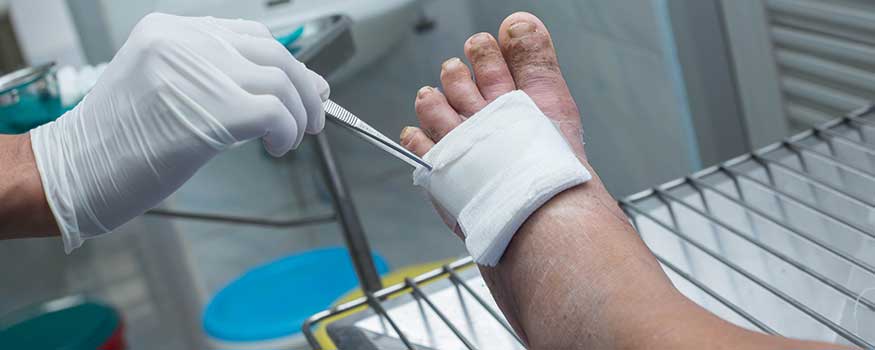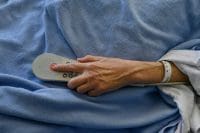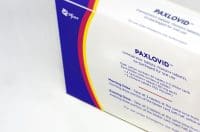Key takeaways
|
More than 29 million Americans have diabetes, and about 5% of them will develop a diabetic foot ulcer (DFU) that may require amputation. In addition to the costs of diabetes itself, DFUs add another $9 billion to $13 billion per year in the United States. Many patients hospitalized for a DFU have significant complications that can lead to poor quality of life, loss of income, inability to perform self-care, and pain.
Many patients hospitalized for major illnesses also have diabetes, making foot assessments essential, especially for those with a history of foot ulcers or the potential for peripheral neuropathy. As a nurse, you’re on the frontline for assessing patients for actual and potential problems. This article presents assessment and patient education tips to help prevent DFUs in hospitalized patients.
Performing a foot assessment
Your foot assessment should include dorsalis pedis and posterior tibialis pulses, foot sensation or loss of protective sensation (LOPS), assessment of existing or previously healed ulcers, recent foot trauma, ischemia, anthropic foot deformities, corns, calluses, fissures, and healed foot or toe amputation. (See Diabetes foot examination.)
When you encounter any of the following findings in your foot assessment, inform the patient’s primary care provider; these findings also may indicate the patient either can’t perform self-care or doesn’t realize a problem exists.
- Blisters, cuts, or bruises
- Bunions, hammertoes, plantar warts, ingrown toenails
- Change in shape of feet
- Calluses on the plantar tip of a hammertoe
- Corns or calluses causing increased pressure to feet
- Dry cracked feet, fissures, or tinea pedis
- Heart disease leading to decrease in oxygenation of feet
- Inability to exercise
- Insensate feet
- Obesity or poor eyesight that restricts self-assessment
- Onychogryphosis (Ram’s horn nails)
- Onychomycosis (fungus and malodorous feet)
- Pain, numbness, or tingling
- Poor glucose control
- Poorly fitting shoes
- Previous toe or foot amputation
- Smoking
If a DFU is found, notify the provider so testing and treatment can begin immediately. (See Guidelines for treatment.)
Peripheral neuropathy
Peripheral nerve damage is common in patients with diabetes, placing them at risk for increased pain or LOPS. Even minor LOPS can lead to falls, accidental burns, traumatic injuries, and foot ulcers.
Begin by asking your patient if he or she has any numbness, tingling, or burning in the feet or lower legs, which may indicate nerve damage. Sensory neuropathy can be detected using a 5.07 monofilament for a quick 10-point plantar foot assessment. Another option is using a tuning fork over bony prominences of the foot to assess deep tendon reflexes.
Motor neuropathy may manifest as loss of Achilles tendon reflex and toe deformities, including hammertoes. It also may lead to abnormality of the musculature of the leg, which may affect the patient’s gait and increase the risk for falls. Any patient with motor neuropathy should always wear shoes and socks during ambulation in the hospital.
Autonomic neuropathy includes microvascular changes resulting in arteriole dysfunction and decreased blood flow in the capillaries, which may result in the feet not being able to sweat. This, in turn, can lead to cracked and fissured feet that are prone to bacteria, increasing the risk of infected DFUs.
Charcot foot deformities
Diabetes affects the blood vessels and leads to poor circulation and weakening of the bones. Over time, this can lead to Charcot foot, which can result in foot fractures the patient is unaware of because of LOPS.
Check for foot deformities and assess for edema, erythema, inflammation, pain, and unusual appearance of the foot. Charcot foot, which may appear as if the patient has a rocker bottom to the foot, requires offloading to stop its progression. If you note calluses, closely inspect them for soft centers with minute drainage, which may provide an avenue for infection. If there’s an open DFU with a Charcot foot deformity, the patient’s provider may involve a team of specialists, including a vascular surgeon to assess circulation, orthopedic or podiatric surgeons, and a wound care specialist. To protect the feet from further damage, after the ulcer is closed, the patient must be fitted for a pair of shoes made for the diabetic foot deformity.
Educational opportunities
Hospitalization can be an excellent time to provide foot care education, including prevention tips. (See Education for prevention.)
Many patients with diabetes or peripheral neuropathy require protective footwear. Tell them about the Medicare Foot Bill, which allows for one pair of shoes for patients with diabetes who are under the care of a primary care provider for longer than 6 months. The bill also allows for shoe inserts for patients at high risk for foot problems.
For patients who can’t perform self-care, encourage regular visits to a podiatrist as prescribed by the primary care provider. And remind them to notify their provider of any changes in their feet.
Increasing awareness, reducing DFUs
DFUs lead to pain and suffering, increased hospitalizations, and amputations. Nursing assessment and education results in greater patient awareness and satisfaction and reduces the chance hospitalized patients will develop DFUs.
DeSales Foster is a nurse practitioner and a wound care specialist at Riddle Hospital Main Line Health System in Media, Pennsylvania.


















